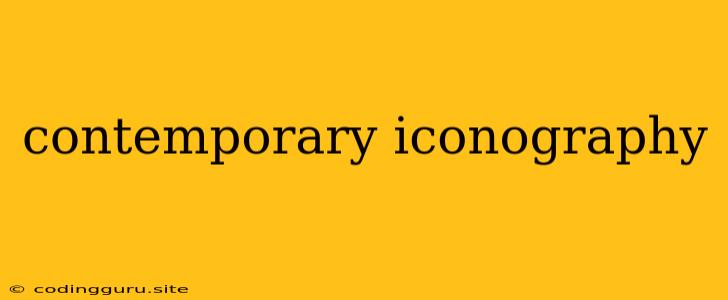Contemporary Iconography: A Shifting Landscape of Visual Communication
The world of visual communication is constantly evolving, and contemporary iconography sits at the heart of this evolution. From the rise of digital platforms to the ever-changing cultural landscape, new forms of visual representation are emerging, challenging traditional iconographic approaches and shaping how we interpret the world around us.
What is Contemporary Iconography?
Contemporary iconography refers to the visual symbols, images, and motifs that are prevalent in contemporary culture. It encompasses a vast range of visual languages, from the instantly recognizable logos of global brands to the intricate illustrations of social media influencers, from the powerful imagery of protest movements to the subtle symbolism woven into everyday design.
What Makes Contemporary Iconography Unique?
Unlike traditional iconography, which often drew upon religious or mythological themes, contemporary iconography is deeply intertwined with the complexities of modern life. It reflects our anxieties, aspirations, and evolving values. Here are some key characteristics that distinguish contemporary iconography:
- Hybridity: Contemporary iconography often blends diverse styles, borrowing from both historical and contemporary art, popular culture, and digital aesthetics.
- Interactivity: The rise of digital media has made contemporary iconography interactive. Think about emojis, memes, and social media filters – these are all examples of how audiences can actively engage with and create their own visual language.
- Multiculturalism: Contemporary iconography reflects the increasingly interconnected world. It draws inspiration from diverse cultures and perspectives, leading to a more inclusive and multifaceted visual language.
- Ephemerality: In the fast-paced digital landscape, contemporary iconography can quickly evolve and become obsolete. Trends emerge and fade, leaving behind a constant stream of new visual symbols.
How is Contemporary Iconography Used?
Contemporary iconography permeates all aspects of our lives, from the products we buy to the messages we consume. It serves a variety of purposes, including:
- Branding and Marketing: Contemporary iconography plays a crucial role in building brand identity and communicating messages to target audiences.
- Social Commentary: Contemporary iconography can be used to express social and political ideas, raising awareness about important issues and sparking dialogue.
- Cultural Representation: Contemporary iconography helps to define and shape cultural identities, reflecting evolving values and beliefs.
- Personal Expression: Contemporary iconography allows individuals to express themselves creatively, sharing their ideas and perspectives with the world.
The Evolution of Contemporary Iconography
Contemporary iconography is constantly evolving, shaped by technological advancements, social movements, and cultural shifts. Here are some notable trends:
- The Rise of Minimalism: Simple, clean lines and bold colors have become increasingly prevalent in contemporary iconography, reflecting a preference for simplicity and clarity.
- The Influence of Digital Culture: The rise of digital platforms has introduced new visual languages, such as emojis, GIFs, and memes, which are now deeply integrated into contemporary iconography.
- The Power of Storytelling: Contemporary iconography is increasingly used to tell stories, conveying complex narratives through evocative imagery.
- The Embrace of Diversity: Contemporary iconography is becoming more inclusive, representing the diversity of human experience and reflecting a wider range of perspectives.
Examples of Contemporary Iconography
Here are some examples of contemporary iconography that illustrate its diverse applications:
- Branding: The Nike swoosh logo is a powerful example of a minimalist icon that has become synonymous with athletic performance and achievement.
- Social Commentary: The "Black Lives Matter" fist is a powerful symbol of the movement for racial justice and equality.
- Cultural Representation: The emoji has become a global language, allowing people to express themselves visually regardless of language barriers.
- Personal Expression: Social media platforms like Instagram and TikTok provide platforms for individuals to express their creativity through visual content, showcasing their unique styles and perspectives.
Exploring Contemporary Iconography
Understanding contemporary iconography is essential for navigating the visual world we live in. Here are some ways to explore this fascinating field:
- Pay attention to the visual symbols around you: From the logos you see on products to the images you encounter online, notice how iconography is being used to communicate messages.
- Research the history of iconography: Understanding the evolution of visual symbols can provide context for contemporary iconography.
- Explore contemporary art and design: Contemporary artists and designers are pushing the boundaries of visual communication, creating innovative and thought-provoking work.
- Engage with social media: Social media platforms are rich with examples of contemporary iconography, from the memes that circulate online to the images used in social activism.
Conclusion
Contemporary iconography is a dynamic and ever-changing aspect of our visual landscape. It reflects our collective anxieties, aspirations, and evolving values, shaping how we perceive and interact with the world around us. By paying attention to the visual symbols that surround us, we can gain a deeper understanding of the complex and fascinating ways in which contemporary iconography communicates meaning.
